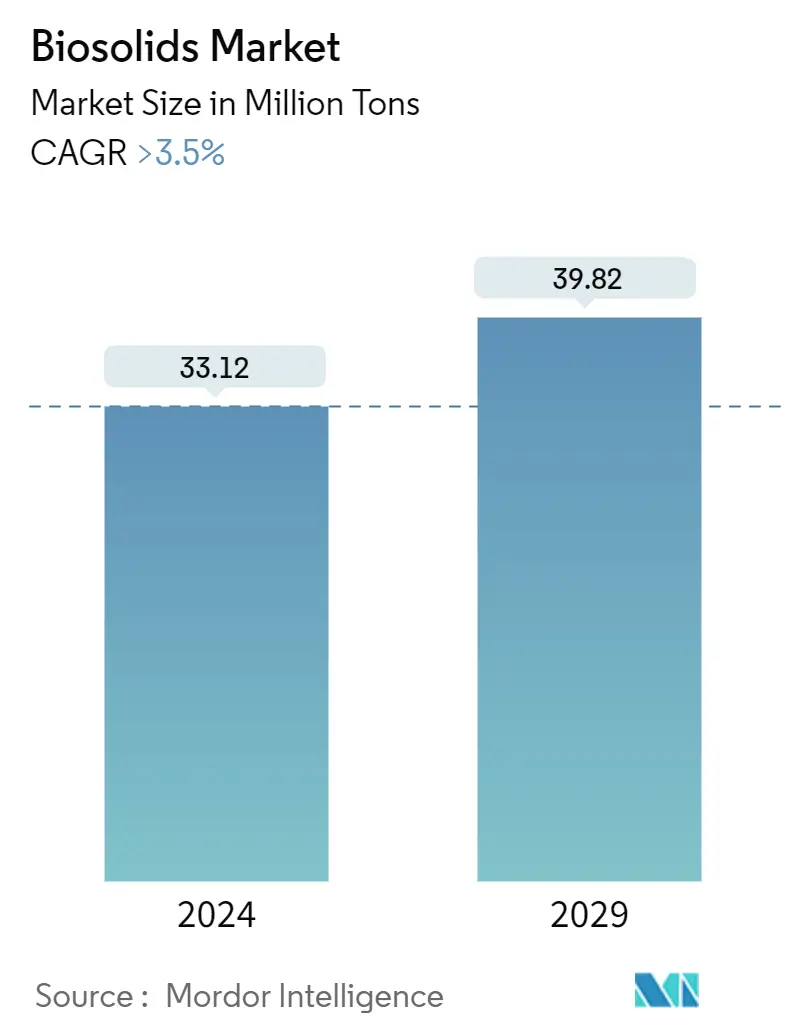Market Size of Biosolids Industry

| Study Period | 2019 - 2029 |
| Base Year For Estimation | 2023 |
| CAGR (2024 - 2029) | 3.50 % |
| Fastest Growing Market | Asia-Pacific |
| Largest Market | North America |
| Market Concentration | High |
Major Players
*Disclaimer: Major Players sorted in no particular order |
Need a report that reflects how COVID-19 has impacted this market and its growth?
Biosolids Market Analysis
The Biosolids Market size is estimated at 33.12 Million tons in 2024, and is expected to reach 39.82 Million tons by 2029, growing at a CAGR of greater than 3.5% during the forecast period (2024-2029).
The COVID-19 pandemic negatively affected the biosolids market in 2020. However, the growing demand for biosolids on agricultural land has fueled overall industry growth since the pandemic.
- One of the main things driving the market that was looked at is the need to replace dangerous chemical fertilizers and strict emission laws in many countries around the world.
- On the other hand, contradictory information about biosolids that is available to the public is expected to slow the growth of the market studied.
- The rising focus on sludge treatment in the Asia-Pacific, mainly in China and India, is anticipated to offer new avenues for industry growth shortly.
- North America dominated the biosolids market due to government and public support for environmental-friendly technologies.
Biosolids Industry Segmentation
Biosolids are organic materials rich in nutrients. They are produced by the treatment of domestic sewage in a wastewater treatment facility. They are a vital resource as they contain essential plant nutrients and organic matter, and they are recycled as fertilizer and soil amendment.
The biosolids market is segmented by type, form, application, and geography. By type, the market is segmented into Class A, Class A EQ, and Class B. By form, the market is segmented into cakes, liquids, and pellets. By application, the market is segmented into agriculture land application, non-agriculture land application, and energy recovery energy production. The report also covers the market sizes and forecasts for the biosolids market in 27 countries across the major regions. Market sizing and forecasting for each segment have been done based on volume (tons).
| Type | |
| Class A | |
| Class A EQ (Exceptional Quality) | |
| Class B |
| Form | |
| Cakes | |
| Liquid | |
| Pellet |
| Application | ||||||
| ||||||
| ||||||
|
| Geography | |||||||||||
| |||||||||||
| |||||||||||
| |||||||||||
| |||||||||||
|
Biosolids Market Size Summary
The biosolids market is poised for significant growth over the forecast period, driven by increasing demand for sustainable agricultural practices and the need to replace chemical fertilizers. The market's expansion is supported by stringent emission regulations and a growing focus on environmental-friendly technologies, particularly in North America. The use of biosolids as fertilizers and soil conditioners is gaining traction, especially in agricultural applications, which dominate the market. This trend is further bolstered by the rising global population and the consequent need for enhanced agricultural yields, particularly in regions like Asia-Pacific, where countries such as China and India are focusing on sludge treatment advancements.
Despite the positive growth trajectory, the biosolids market faces challenges, including public misconceptions that may hinder its expansion. However, the market's partially consolidated nature, with key players like REMONDIS SE & Co. KG, Cambi ASA, and others, indicates a competitive landscape that is actively pursuing strategic acquisitions and partnerships to enhance market presence. Notable developments, such as Synagro Technologies Inc.'s acquisition of Burch Hydro Inc. and the San Francisco Public Utilities Commission's investment in biosolids digestion facilities, highlight ongoing efforts to modernize and expand biosolids management capabilities. These initiatives are expected to further solidify the market's growth prospects in the coming years.
Biosolids Market Size - Table of Contents
-
1. MARKET DYNAMICS
-
1.1 Drivers
-
1.1.1 Replacing Hazardous Chemical Fertilizers in North America
-
1.1.2 Stringent Government Emission Laws
-
1.1.3 Other Drivers
-
-
1.2 Restraints
-
1.2.1 Lack of Proper Knowledge and Awareness on Biosolids
-
1.2.2 Other Restraints
-
-
1.3 Industry Value Chain Analysis
-
1.4 Porter's Five Forces Analysis
-
1.4.1 Bargaining Power of Suppliers
-
1.4.2 Bargaining Power of Consumers
-
1.4.3 Threat of New Entrants
-
1.4.4 Threat of Substitute Products and Services
-
1.4.5 Degree of Competition
-
-
-
2. MARKET SEGMENTATION (Market Size in Volume)
-
2.1 Type
-
2.1.1 Class A
-
2.1.2 Class A EQ (Exceptional Quality)
-
2.1.3 Class B
-
-
2.2 Form
-
2.2.1 Cakes
-
2.2.2 Liquid
-
2.2.3 Pellet
-
-
2.3 Application
-
2.3.1 Agriculture land Application
-
2.3.1.1 Fertilizer/Soil Conditioner for Human Crop Production
-
2.3.1.2 Fertilizer for Animal Crop Production - Pastures
-
-
2.3.2 Non-agricultural Land Application
-
2.3.2.1 Forest Crops (Land Restoration and Forestry)
-
2.3.2.2 Land Reclamation (Roads and Urban Wetlands)
-
2.3.2.3 Reclaiming Mining Sites
-
2.3.2.4 Landscaping, Recreational Fields, and Domestic Use
-
-
2.3.3 Energy Recovery Energy Production
-
2.3.3.1 Heat Generation, Incineration, and Gasification
-
2.3.3.2 Oil and Cement Production
-
2.3.3.3 Commercial Uses
-
-
-
2.4 Geography
-
2.4.1 Asia-Pacific
-
2.4.1.1 China
-
2.4.1.2 India
-
2.4.1.3 Japan
-
2.4.1.4 South Korea
-
2.4.1.5 Malaysia
-
2.4.1.6 Thailand
-
2.4.1.7 Indonesia
-
2.4.1.8 Vietnam
-
2.4.1.9 Rest of Asia-Pacific
-
-
2.4.2 North America
-
2.4.2.1 United States
-
2.4.2.2 Canada
-
2.4.2.3 Mexico
-
-
2.4.3 Europe
-
2.4.3.1 Germany
-
2.4.3.2 United Kingdom
-
2.4.3.3 Italy
-
2.4.3.4 France
-
2.4.3.5 Spain
-
2.4.3.6 NORDIC
-
2.4.3.7 Turkey
-
2.4.3.8 Russia
-
2.4.3.9 Rest of Europe
-
-
2.4.4 South America
-
2.4.4.1 Brazil
-
2.4.4.2 Argentina
-
2.4.4.3 Colombia
-
2.4.4.4 Rest of South America
-
-
2.4.5 Middle East and Africa
-
2.4.5.1 Saudi Arabia
-
2.4.5.2 South Africa
-
2.4.5.3 Nigeria
-
2.4.5.4 Qatar
-
2.4.5.5 Egypt
-
2.4.5.6 United Arab Emirates
-
2.4.5.7 Rest of Middle East and Africa
-
-
-
Biosolids Market Size FAQs
How big is the Biosolids Market?
The Biosolids Market size is expected to reach 33.12 million tons in 2024 and grow at a CAGR of greater than 3.5% to reach 39.82 million tons by 2029.
What is the current Biosolids Market size?
In 2024, the Biosolids Market size is expected to reach 33.12 million tons.

